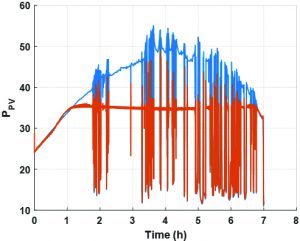Solar Variability Reduction Using Off-MPP Tracking and Energy Storage Systems
PhD student Jason Galtieri with advisor P. Krein
Maximum power point (MPP) tracking is the standard control scheme for photovoltaic (PV) arrays of all sizes. Inverter tracking algorithms work on second to sub-second time scales and can track most naturally occurring irradiance changes, such as moving cloud coverage. Fast response tracking imposes large power swings on the grid which must be absorbed in spinning reserves. As PV penetration increases and replaces traditional spinning generation, there is concern the grid’s voltage and frequency stability could be compromised.
For practical scenarios, MPPT maximizes the variability a PV array imposes on the grid and minimizes the control provided to the array operator and/or utility. The MPP is determined entirely by the available irradiance, which can be difficult or error-prone to forecast. To date, active array control has mainly taken the form of curtailment during periods of overproduction, but these methods are relatively slow and limited. In our work, supported by the Grainger Center for Electric Machinery and Electromechanics, off-MPP set-point strategies which use ripple correlation control (RCC) to quickly find the MPP current and voltage, are proposed. The MPP data is then fed into an off-MPP set-point controller to operate at a reduced set point. RCC algorithms converge in millisecond time frames, so the MPP data can be updated several times a second to maintain accuracy. Likewise, the off-MPP converters converge on similar time scales, so the converters spend most of their time at the reduced set point. Figure 1 shows experimental results for a PV simulator and an RCC controller with a 35 W set point. The blue line represents seven hours of solar data fed into the emulator and the orange line is the power output of the RCC controller. Good off-MPP tracking efficiency is observed when the set point is reachable.
